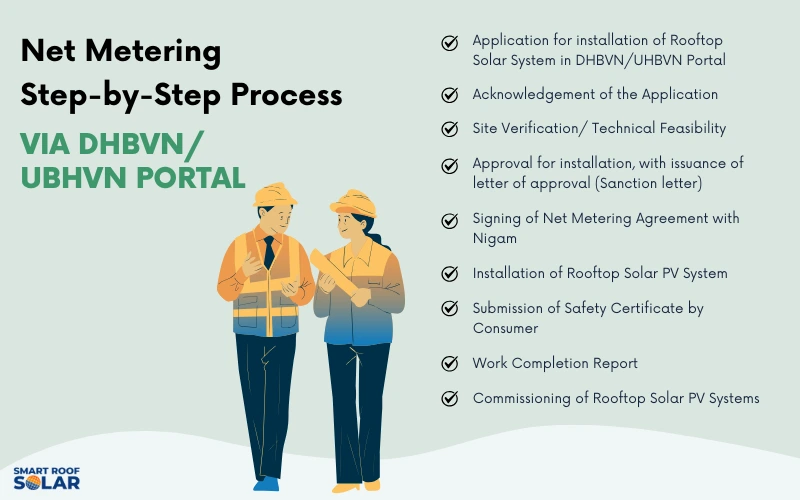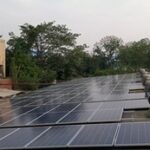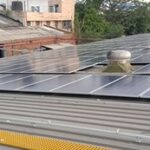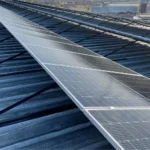Save on Electricity in Haryana Using Net Metering: A Complete Guide
Save on Electricity in Haryana Using Net Metering: A Complete Guide
The increasing electricity tariffs in India are pushing house owners and businesses to explore affordable and environmentally clean energy solutions. Rooftop solar systems and net-metering, being a smart cost-saving method, have been gaining traction in the current market. This allows users to lower their electricity bills and earn from the excess energy produced.
In Haryana, the government has introduced a structured net metering procedure, making it simpler for residents to shift to solar electricity. This blog will guide you through the basics of net metering and the application process of net metering in Haryana.
What is Net-metering
Net metering is a method that allows you to send back any excess electricity generated to the grid. So instead of storing energy in batteries, you earn credits on them. The user only pays for the net energy used (Generated – Consumed) at the end of the month.
Usually, when a solar panel produces electricity in the daylight, it is consumed and stored for later, unfavorable weather conditions, like rainy season or cloudy days. By the end of the month, if the amount of consumed energy is less than the amount of generated energy, then the user is credited for the excess energy generated. This is only possible through net metering.
Benefits of Net-metering
Net metering is not only pocket-friendly, but also very useful in a broader sense. With solar producing its own electricity, it is environmentally feasible as well as economical. Let’s see some of the benefits that it provides –
- Net-metering helps avoid major electricity charges and helps the users earn credits for the electricity supplied back to the grid.
- It has the fastest ROI, like 4-5 years, for the residential users.
- Reduce your carbon footprint by switching to renewable energy.
- Solar systems require minimal upkeep post-installation.
Net Metering Process in Haryana
Below is the entire process of how one can apply for net metering in Haryana through the DHBVN/UHBVN e-portal.

Step 1: Application for the installation of rooftop solar
- Go to UHBVN or DHBVN and create an account.
- Fill in basic consumer details like account number, mobile number, and email address.
Step 2: Submit the Solar Application
- Select the capacity (in kW) of the rooftop solar system.
- Upload the required documents and keep them handy –
- Occupancy proof along with roof rights(for residential).
- Registered Sale Deed of property/ Registered GPA/Registered Lease
- Deed/Allotment letter (for businesses)
- Latest paid electricity bill (not older than 3 months)
- Pan card of the applicant
- Photo (Applicant)
- Adhaar Card
- Memorandum of Article(MOA), Company PAN, and GST certificate (for businesses)
Note: – Name of the applicant should be the same on the Residential Proof, Aadhar card, and electricity bill.
Step 3: Feasibility Approval
- The DISCOM (DHBVN/UBHVN) will appoint an SDO to verify the site, and then the system feasibility will be verified for a capacity of up to 5 kWp.
- And then approval or rejection is generally provided within 15–20 working days by the XEN (OP).
Step 4: Installation of Solar Panels
- After feasibility approval, you can proceed with installation using an approved vendor, listed under ALMM.
- Installation should be done within 180 days from the date of the LOA.
Step 5: Work Completion Report
- The applicant needs to submit the work completion report along with enclosures.
Step 6: Submission of the safety certificate by the consumer
- For systems up to 20 kWp, work completion by the agency is sufficient. But for systems above 20 kWp, an inspection report by the Chief Electrical Inspector is required.
Step 7: Commissioning of Rooftop Solar PV System
- The meter will be provided by the agency, and if not available in the Nigam Store, the Meter with the issue specifications must be purchased and set up.
- After submission of work completion and CEIG/safety certificate, the Joint Commissioning of the RTS plant will be uploaded by the SDO on the portal.
Things to Keep in Mind Before Applying
- Make sure to check your sanctioned load. One can’t apply for a solar system capacity more than that.
- Choose a certified/ALMM vendor before applying for a subsidy.
- Make sure your roof is shadow-free for 5-6 hours daily for maximum generation.
- Keep your electricity bill and meter readings handy while filling out the application.
Conclusion
Net metering is not just an eco-friendly choice, but it’s a smart financial decision for residents. The government has also simplified the application process by giving them an online facility.
Start your application today with Smart Roof Solar and turn your rooftop into a power plant.
FAQs
Q1. Can I install a solar system without applying for net metering?
Ans: Yes, you can install a solar system for personal use without applying for net metering. However, without a net metering connection, you won’t be able to send excess power back to the grid or earn credits.
Q2. Is net metering available for both single-phase and three-phase connections?
Ans: Yes, net metering is applicable to both single-phase and three-phase electricity connections, but the applicable capacity and technical requirements may vary based on your connection type.
Q3. Can tenants apply for net metering if they live in a rented house?
Ans: Tenants can apply if they provide valid proof of occupancy and written consent from the property owner granting rights to use the rooftop for solar installation.
Q4. Are there any penalties for delayed installation after feasibility approval?
Ans: Yes, installations must be completed within 180 days of receiving the Letter of Approval (LOA). Delays beyond this period can lead to cancellation of the application or require re-approval.
Q5. Can I monitor my solar system’s performance in real time?
Ans: Yes, most modern rooftop systems come with smart monitoring tools or mobile apps that allow users to track energy generation, usage, and grid export in real-time.
Suggested Articles

Affordable Solar Systems and Plants for Small and Medium Enterprises
Learn how SMEs can harness solar energy through tailored solar systems and plants to reduce electricity bills, improve sustainability, and boost efficiency.

Are Colleges and Schools ready to take up Solar challenge?
Adopting solar energy can help schools and colleges reduce electricity costs and promote sustainability. This guide explores how educational institutions can implement rooftop solar projects, the benefits, and what steps are needed to take on the solar challenge effectively.

Solar Net Metering in Industrial Units: Opportunities and Risks
Solar net metering can help factories save on energy costs, but there are key pitfalls to consider. Learn the challenges and best practices for industrial adoption

New Loan Scheme for solar rooftop projects by IREDA
IREDA has introduced a new loan scheme to make rooftop solar projects more accessible. This guide covers eligibility criteria, benefits, application process, and how businesses and homeowners can leverage this scheme to invest in clean and affordable solar energy.

How Azimuth Angle Impacts Solar Panel Efficiency for Homes, Industries, and Commercial Buildings
Discover how solar panel azimuth impacts energy generation in homes, industries, and commercial buildings. Maximize efficiency with correct orientation.

Solar Rooftop: अपने घर को बनाओ खुद का पावर हाउस | Complete Guide
सौर रूफटॉप सिस्टम आपके घर को पावर हाउस बना सकता है। यह न केवल बिजली के बिलों में बचत करता है, बल्कि साफ और नवीकरणीय ऊर्जा भी प्रदान करता है। जानें सौर पैनल की इंस्टालेशन प्रक्रिया, लागत, लाभ और कैसे यह आपके घर को आत्मनिर्भर ऊर्जा का स्रोत बना सकता है।

Solar Industry Faces Growing Losses from Underperforming Equipment
According to the Raptor Maps’ Global Solar Report, the amount of power loss due to equipment anomalies has nearly doubled from 1.61% in 2019 to 3.13% in 2022. This trend is expected to continue, with anomaly-driven power loss potentially growing to almost 6% by 2025.

Understanding Solar Cells and Modules: A Complete Guide
Understand solar cells and modules, their functioning, and advantages for residential and commercial solar installations.